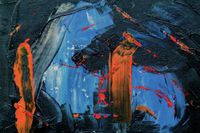Statue of Jackie Robinson Stolen and Burned
A statue of Jackie Robinson, the first Black player in Major League Baseball, was stolen and later found burned in Wichita, Kansas.

ROBINSON ROBBED
A Jackie Robinson statue in Wichita, Kansas was stolen and later found burned. On January 24, the statue of the first Black player in Major League Baseball and a civil rights activist was cut off its pedestal and removed from McAdams Park. Two people were captured on surveillance footage committing the crime. Days later, firefighters discovered some of the statue remnants among burnt items in a trash can. A GoFundMe campaign has been launched to replace the artwork and has already raised over $168,500. Bob Lutz, the executive director of the nonprofit League 42, which installed the sculpture, expressed shock and confusion over the incident.
The theft of the Jackie Robinson statue has sparked outrage and prompted investigations. Authorities are puzzled as to why someone would commit such an act and are working to identify the culprits. The community has rallied together to raise funds for a replacement statue, highlighting the significance of Jackie Robinson's impact on the game of baseball and the civil rights movement. The incident serves as a reminder of the ongoing racial tensions and the need to address and combat acts of hatred and vandalism.
The statue of Jackie Robinson serves as a symbol of progress and equality, honoring his pioneering role in breaking the color barrier in professional baseball. It is disheartening to see such an important piece of artwork destroyed in an act of theft and arson. The community's response in rallying together to support the replacement of the statue demonstrates the enduring legacy of Jackie Robinson and the impact he continues to have on both the sports world and society as a whole.
Controversy Over Painting of Jesus
A painting depicting Jesus Christ in the nude, intended to be the poster for Easter Week in Seville, Spain, has sparked controversy and calls for its removal. The artwork, created by local artist Salustiano Garcia, portrays Jesus after his resurrection, following a long-standing tradition in art history. However, critics have denounced the painting as "effeminate," "sexualized," and "offensive." A petition calling for the poster to be scrapped has gained over 10,000 signatures.
The controversy surrounding the painting of Jesus highlights the ongoing debate over artistic interpretation and religious sensitivities. While the artist claims his artwork was created with respect, critics argue that it crosses boundaries and promotes a distorted view of a sacred figure. The heated response to the painting underscores the complex relationship between art and religion and the potential for deeply held beliefs to clash with artistic freedom.
The controversy surrounding the painting of Jesus in Seville serves as a reminder of the power of art to provoke strong emotions and ignite debates. It also raises questions about the boundaries of artistic expression and the role of censorship in balancing freedom of speech with respect for religious beliefs. The public outcry and demands for the removal of the painting reflect the deep-rooted convictions held by individuals and their desire to protect what they hold sacred.
Closure of Rubin Museum of Art
The Rubin Museum of Art, dedicated to the art of the Himalayas, has announced its closure in October and the layoff of approximately 40 percent of its staff. The institution plans to continue operating as a research-facilitating organization and lending works, despite the physical closure of its museum space. The decision to close the museum is not directly related to recent controversies surrounding repatriated parts of the collection.
The closure of the Rubin Museum of Art highlights the challenges faced by cultural institutions, particularly in light of the COVID-19 pandemic. The economic impact of the pandemic, combined with ongoing financial struggles, has forced the museum to make difficult decisions. However, the museum's commitment to maintaining its role as a research-focused organization demonstrates its dedication to preserving and sharing the cultural heritage of the Himalayas.
The closure of the Rubin Museum of Art represents a loss for the art community and the broader public. The museum's collection of Himalayan art holds great cultural and historical significance, and its closure raises concerns about the preservation and accessibility of these artworks. Despite the closure, the institution's decision to continue operating in a different capacity reflects its resilience and commitment to fulfilling its mission amidst challenging circumstances.



